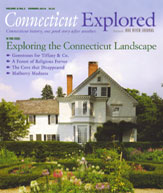(c) Connecticut Explored Inc. Summer 2010
Subscribe/Buy the Issue!
Here at Connecticut Explored, we’re interested not just in the past but in its connection to the present and future. Perhaps nowhere is this connection more apparent than in the areas of land conservation and urban “green” initiatives.
The way a parcel of land has been used in the past can strongly influence its future use. One shining example is the Farmington Canal Linear Park, which has been under development for more than 20 years. This approximately 70-mile ribbon of contiguous pieces of land between New Haven and Suffield exists today because of a grand scheme in 1821 to build a canal (see “The Ill-Fated Canal,” Spring 2008) that would enable New Haven to compete against Hartford and other ports on the Connecticut River for business in northern New England. The canal failed 27 years later, then served as a rail line for the next 140 years. The rail line in turn fell out of use just as the “Rails-to-Trails” greenway movement gained momentum in the 1980s, and sections in Cheshire, Hamden, Farmington, and Avon were relatively easily transformed into a series of linked paved recreational paths for walking and biking. But the connection between Hamden and New Haven in the southernmost section was almost lost to—you guessed it—a mall.
And that’s where the story incorporates another theme we love: the power of a single person to change the course of history. In this case, that person is Nancy Alderman. As Randall Beach reported in the New Haven Register (November 2, 2009) on the occasion of the ribbon cutting for that half-mile link between the New Haven and Hamden sections of the trail, Alderman, who opposed the Hamden mall project proposal in 1987, stumbled (literally) upon the abandoned canal/rail line while walking the parcel in question. When she called the Interstate Commerce Commission for information about the rail line, she learned that the environmental and historical impact studies required before the mall project could proceed had not been done. A lawsuit halted the sale of the land to developers. Today, a 14-mile trail from Yale’s campus at the southern terminus north to Cheshire exists due to Alderman’s intervention—and because history matters. (Visit the Farmington Canal Heritage Trail HERE.)
Take a look through this issue and you’ll find other connections between past and present in the Connecticut landscape. The mulberry tree craze of the mid-1800s reminds us that speculative investments are not solely a 21st-century phenomenon. A trio of stories from Connecticut Landmarks, an organization perhaps best known as a keeper of historic-house museums but that offers so much more (the state’s largest farmer’s market, for example), has us “looking down” to consider the history of the land beneath the sites. And John Pawloski digs into the fascinating aspects of Connecticut’s pegmatite-mining history. (Feldspar mined from pegmatite was a key ingredient in Connecticut-invented Bon Ami cleanser.)
Look for the “Explore” boxes throughout the magazine for the information you need to visit sites related to our articles. We hope you’ll be inspired by these stories to get out and explore!
Explore!
Read all of the stories in the Summer 2010 issue
Read all of our stories about the historic Connecticut landscape & environment on our TOPICS page
Kids’ Page: Ride the Farmington Canal Heritage Trail

